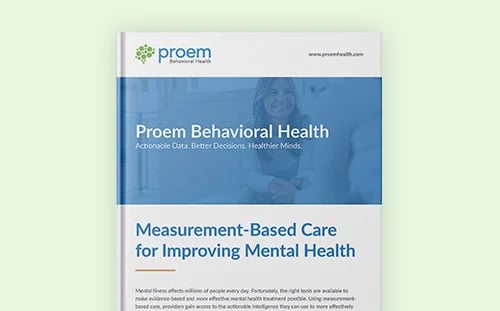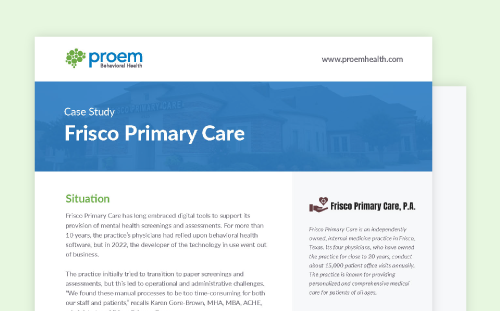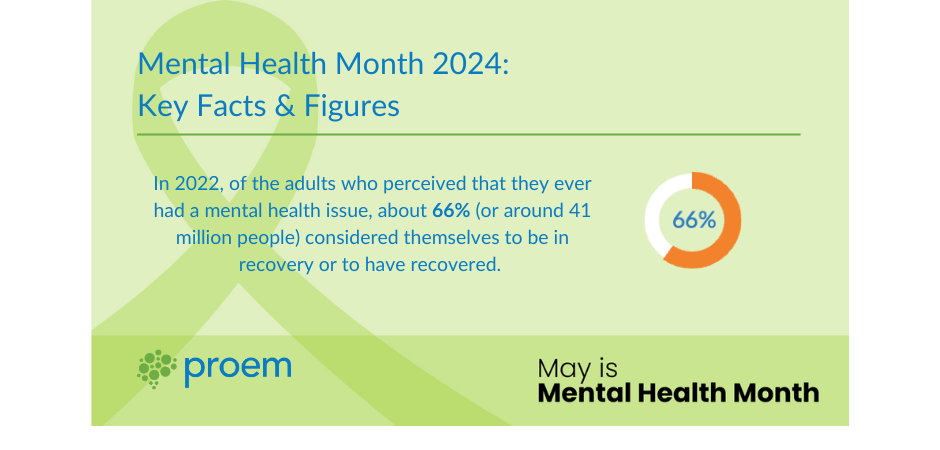
As the developer of evidence-based mental health assessment and measurement technology, Mental Health Month has significant meaning to the Proem Behavioral Health team. Our mission is to simplify and improve the mental health care journey for providers and patients. Mental Health Month provides an opportunity to step back, assess the status quo and recognize all the reasons the current mental health system is broken. We can use this recognition and understanding as a catalyst to stop accepting the state of failure and join together to pursue a makeover of our mental health care system and better tackle the substantial mental health crisis.
To help you gain a better understanding of Mental Health Month and why it is a valuable period to renew our efforts to improve outcomes and continue to work to overcome mental illness with timely, accurate diagnoses and treatments, here are 25 things to know about the month-long observance and the current state of global and national mental health.
- Mental Health Month was established in the United States in 1949.
- It is sometimes described as Mental Health Awareness Month.
- Mental Health Month is observed every May in the U.S. World Mental Health Day is held October 10.
- For 2024, Mental Health America's (MHA) theme for Mental Health Month is "Where to Start: Mental Health in a Changing World." In explaining the theme, MHA notes, "While society is getting more comfortable discussing mental health, it can still be hard to know 'Where to Start' when it comes to taking care of your own well-being."
- For 2024, the National Alliance on Mental Illness (NAMI) is celebrating Mental Health Awareness Month with its "Take the Moment" campaign. Among the reasons for the theme: "This campaign also champions the importance of destigmatizing mental health by normalizing the practice of taking moments to prioritize mental health care without guilt or shame," according to NAMI.
- Green is the international color of mental health awareness.
- In 2019, one in every eight people, or 970 million people, around the world were living with a mental health disorder.
- Anxiety and depressive disorders are the most common global mental health disorders.
- A large-scale study projects that one out of every two people in the world are expected to develop a mental health disorder in their lifetime.
- The three most common mental health disorders among women are depression; specific phobia, a disabling anxiety that interferes with daily life; and post-traumatic stress disorder (PTSD).
- The three most common mental health disorders among men are alcohol abuse, depression and specific phobia.
- More than one in five U.S. adults live with a mental illness.
- In 2021, there were an estimated 58 million adults aged 18 or older in the U.S. with any mental illness.
- Over one in five youth (ages 13-18) either currently or at some point during their life have had a seriously debilitating mental illness.
- About one in 25 U.S. adults lives with a serious mental illness, such as schizophrenia, bipolar disorder or major depression.
- In 2022, about 49 million people aged 12 or older (or about 17%) had a substance use disorder (SUD) in the previous year, including nearly 30 million who had an alcohol use disorder (AUD), 27 million who had a drug use disorder, and 8 million people who had both an alcohol use disorder and a drug use disorder.
- Due to the COVID-19 pandemic, the number of worldwide anxiety and depressive disorders grew. Depressive symptoms grew from about 193 million people to 246 million, while anxiety disorders grew from about 298 million people affected to 374 million.
- Ninety percent of the public think there is a mental health crisis in the U.S.
- An estimated one-third of those who wanted to receive mental health services could not do so. Barriers to accessing care cited include cost, shame and stigma as main obstacles.
- The shortage of mental health providers is also creating challenges, with about 60% of psychologists reporting no openings for new patients.
Despite the mental health challenges many are facing, there's encouraging news.
- In 2022, of the adults aged 18 or older who perceived that they ever had a mental health issue, about 66% (or around 41 million people) considered themselves to be in recovery or to have recovered.
- And in 2022, of those adults aged 18 or older who perceived that they ever had a substance use problem, about 71% considered themselves to be in recovery or to have recovered.
- A 2023 nationwide survey found that 81% of U.S. adults reported their mental health as good, very good or excellent.
- People are taking advantage of resources that can provide mental health assistance. For example, since its July 2022 launch, the 988 Suicide & Crisis Lifeline has received about 10 million calls, texts and chats.
- A study found that there has been a significant decrease in public stigma toward major depression.
Sources:
- American Psychological Association
- Centers for Disease Control and Prevention
- Harvard Medical School
- JAMA Network Open
- The Lancet
- The Lancet Psychiatry
- Mental Health America
- Mental Health Foundation
- National Institute of Mental Health
- Substance Abuse and Mental Health Services Administration
- World Health Organization
- Youth.gov





.png)






